 A new M in charge: will the M3 Ultra achieve pro audio domination?
A new M in charge: will the M3 Ultra achieve pro audio domination?
Apple’s M‑series Macs continue to power ahead. We benchmark the latest Mac mini, MacBook Pro and Mac Studio models for audio performance.
With one exception, Apple have upgraded or reintroduced new models of every single Macintosh in the last few months. Last October, the company unveiled updates to their iMac and MacBook Pro families — in addition to a brand‑new Mac mini — with March bringing an updated MacBook Air and Mac Studio, which takes the crown as “the most powerful Mac ever”. Most of these are based around their latest M4 processor. The M4 debuted in the iPad Pro back in May 2024, but it was only a matter of time before Apple brought this latest silicon to the Mac, and, in doing so, continued the established pattern of augmenting the standard chip configuration with more powerful Pro and Max variants.
What’s It All M4?
The M4 represents a significant leap over the M1 and M2 architectures already familiar to musicians and audio engineers, building on the M3 chips released a year earlier. The M3 family were the first personal computer chips to be fabricated on a 3nm process node using TSMC’s N3 technology. This was significant because, simply put, moving to a smaller process allows for tinier transistors and greater transistor density, which can afford improvements in both performance and power efficiency. Prior M‑series chips were fabricated on a 5nm process, so even if Apple had just manufactured the existing M2 chip with the newer N3 technology, it would theoretically have resulted in a more energy‑efficient chip with better performance.
However, the M3 was more than just the sum of its process. Where the M2 had been an evolution and refinement of the M1, offering around a 20 percent increase in real‑time audio performance, the M3 represented a much bigger leap. Thanks to significant advances in both manufacturing and architecture, the M3 Max delivered 58 to 75 percent more audio processing compared to the M2 Max, depending on the host application. So key were the M3’s gains that the M3 Ultra can outperform an M4 Max — much as an M1 Ultra could surpass an M2 Max. Consequently, whereas the base model in the new Mac Studio line features an M4 Max CPU, the top‑end model is based around the new M3 Ultra.
Core Performance
As you may already be aware, M‑series chips employ a heterogeneous architecture for general‑purpose computing tasks. This means that while every CPU core supports the same basic instruction set capable of executing the same code, there are two types of cores, with different performance and efficiency characteristics. Performance (P) CPU cores are finely tuned for high performance, whereas Efficiency (E) cores are optimised for handling less demanding tasks using the least amount of energy. Music applications typically rely on P cores for real‑time audio, leaving the E cores to handle other, non‑real‑time tasks such as lookahead processing.
However, applications can’t directly assign specific tasks to certain cores. Instead, macOS 11 introduced the Audio Workgroups API, enabling applications or plug‑ins to flag certain tasks as being responsible for handling real‑time audio. This, in turn, allows macOS to optimise the usage of performance and efficiency cores to achieve glitch‑free playback. And although such a scheduling system isn’t perfect, it generally provides the best possible overall performance. Because whilst one application or plug‑in can’t know the specific processing requirements of another, macOS knows everything — at least in terms of an application’s needs.
The M3 was a notable advancement over the M2, introducing a next‑generation GPU architecture alongside many key advancements to the design of the CPU cores, such as improved branch prediction. Simply put, branches are points in a program where a condition needs to be evaluated to figure out what happens next. A naïve example might be to check if a channel is muted on a mixer: if the channel is muted, the program can skip over that channel and proceed to the next one, but if the channel is not muted, the program will need to process the playback required from that channel.
To speed up the execution of our modest mixer, a branch predictor would make an educated guess as to whether a given channel is muted or not based on its previous state. If the branch predictor guesses correctly, the CPU will have already started processing the correct instructions ahead of time, allowing the program to run smoothly. However, if the prediction is wrong, the CPU must discard the instructions that were speculatively processed and reprocess the correct ones, which can adversely affect performance.
In practice, branch prediction works at a much lower level, enhancing DSP algorithms where decision making is inherently part of the process. For example, a limiter needs to decide whether incoming audio samples are above or below the threshold. If the current sample is above the threshold, it’s very likely this condition will be true for the next sample. Therefore, the CPU can predict the outcome for the next cycle.
The P cores also feature wider decode and execution engines, both of which enhance audio processing performance. A wider decode engine allows more instructions to be processed simultaneously, while a wider execution engine enables more of those instructions to be executed in parallel. Such improvements benefit both traditional DSP algorithms — especially computationally intensive effects like convolution reverb — and modern machine‑learning‑based audio effects for restoration and assisted mixing.
Apple claimed the M3’s performance cores were up to 30 and 15 percent faster compared to the M1 and M2 respectively, with the efficiency cores achieving a greater increase of up to 50 and 30 percent. Perhaps most impressively, though, and thanks in no small part to the 3nm process, the M3’s architecture could deliver the same multi‑threaded CPU performance as the M1 using half the power.
From London To South Wales
The M4 builds on these architectural advancements, with the performance core offering further improvements in branch prediction, the ability to decode 10 instructions simultaneously, a 40 percent larger reorder buffer, and what Apple refer to as “Next Generation ML [Machine Learning] Accelerators” (see box). The larger reorder buffer helps to improve general compute performance, but has fewer direct benefits when running DSP code, for reasons that are a little beyond the scope of this article. However, it can still improve the performance of audio applications and plug‑ins, for example, by speeding up the execution of user interface handling and so leaving more resources available for executing DSP code.
Differ‑M‑tiation
The Pro and Max variants of the M1 and M2 families shared many similarities, particularly in terms of CPU core configurations. While the standard chips each featured four performance cores and four efficiency cores, the Pro and Max versions were equipped with eight P cores, with a more affordable Pro option offering six P cores. The M1 Pro and Max chips had two E cores, while the M2 Pro and Max chips offered four.
For the ultimate performance, Apple then introduced an Ultra variant. The M1 Ultra debuted with the Mac Studio, while the M2 Ultra arrived alongside the first Mac Pro based on Apple Silicon. However, unlike other M‑series chips, the Ultra combines two Max dies interconnected via an Apple‑designed high‑speed fabric known as UltraFusion. This technology allows the system to treat the package as a single unified chip with double the resources. As a result, the Ultra delivers not only twice the number of CPU and GPU cores, but also dual Neural and Media Engines.
The Pro and Max variants of the M1 and M2‑series chips were both available in identical 10‑ or 12‑core configurations, and consequently, systems containing these chips achieved similar levels of performance. However, the Pro and Max variants were still distinct in other ways such as the amounts of physical memory supported and the number of GPU cores and video encode and decode engines.
With the release of the M3 family, Apple kept the same eight‑core composition for the standard M3 chip, but decided to more significantly differentiate the number and distribution of cores in the Pro and Max configurations. The M3 Pro was available with either 11 or 12 CPU cores, comprising six E cores and either five or six P cores, whereas the M3 Max became further maximised by offering 14 or 16 CPU cores, featuring four E cores with either 10 or 12 P cores. The belated M3 Ultra combines two M3 Max dies, but unlike previous generations, is available in two variations, depending on which variant of the M3 Max it uses. Both offer eight E cores, and you can choose either 20 or 24 P cores.
With the M4 series, Apple have once again decided to rebalance the CPU core configurations. The standard M4 in the Mac is a 10‑core chip with six P cores and four E cores. The M4 Pro is available in 12‑ or 14‑core versions featuring four E cores and either eight or 10 P cores, while the M4 Max configurations have also been upgraded to comprise 12 or 14 cores, each featuring the same four E cores, adding either eight or 10 P cores. Another significant change with the standard M4 chip is the inclusion of 16GB unified memory as standard — arguably a long‑overdue decision. Previously, 8GB had been the minimum for base models.
As we will see, the real‑world difference in application performance between the M4 Max and M3 Ultra is, frankly, chasm‑like!
Figure 1 shows that the Geekbench results for Apple’s new chips are mostly as one would expect, aside from one noticeable anomaly: the multi‑core score for the new M3 Ultra chip. According to this result, the Mac Studio with M3 Ultra appears to be less than six percent more powerful than the M4 Max‑based model — an increase that would hardly justify the price gap, even considering other differences in the specifications. However, I think this result is indicative of a flaw in Geekbench’s benchmarking rather than being reflective of the M3 Ultra’s raw horsepower. As we will see, the real‑world difference in application performance between the M4 Max and M3 Ultra is, frankly, chasm‑like!
 Figure 1: This chart shows the results of Geekbench 6’s single‑ and multi‑core CPU tests for the Macs featured in this review, along with results for older systems and the M4‑based iPad Pro. (The number of CPU cores are indicated in brackets for systems available in different configurations.)
Figure 1: This chart shows the results of Geekbench 6’s single‑ and multi‑core CPU tests for the Macs featured in this review, along with results for older systems and the M4‑based iPad Pro. (The number of CPU cores are indicated in brackets for systems available in different configurations.)
The Mini Studio
The design of the new Mac mini with M4 clearly owes much to the Mac Studio; indeed, a more apropos name might have been the Mac Studio mini. Apple have shrunk the 7.7 x 3.7‑inch dimensions of the Mac Studio to a 5 x 2‑inch cuboid. An honourable mention must be given to the team that engineers Apple’s power supplies. It’s remarkable when you consider that, in addition to housing such a powerful system within a compact aluminium enclosure, Apple also manage to integrate a 155W power supply within the Mac mini’s tiny form factor. The Mac mini by itself could easily be mistaken for the power brick of a competing product!
 Despite its size, the Mac mini is surprisingly capable!
Despite its size, the Mac mini is surprisingly capable!
Considering its size, the new Mac mini offers a surprising array of connectivity. The 3.5mm headphone jack has finally been moved to the front of the device, accompanied by two USB‑C ports with support for USB 3 (up to 10Gb/s). Sadly, however, this means there is no space for any USB‑A ports.
The power button, previously located at the rear of the Mac mini, has also been relocated. However, rather than moving this seemingly vital control to, say, the front, or maybe the side, Apple’s engineers have instead decided to place it underneath. This makes it hard for the button to be pressed accidentally, but, for the same reason, it also makes it hard for the button to be pressed intentionally. In practice, this is only really inconvenient during Touch ID setup, where a physical button press is required to confirm secure intent and establish a direct connection to the Secure Enclave.
A more important consideration is that the base model Mac mini with M4 and a 256GB SSD delivers lower data transfer rates when compared with the more expensive, higher‑capacity alternatives (as you can see from the Blackmagic Disk Speed Test results).
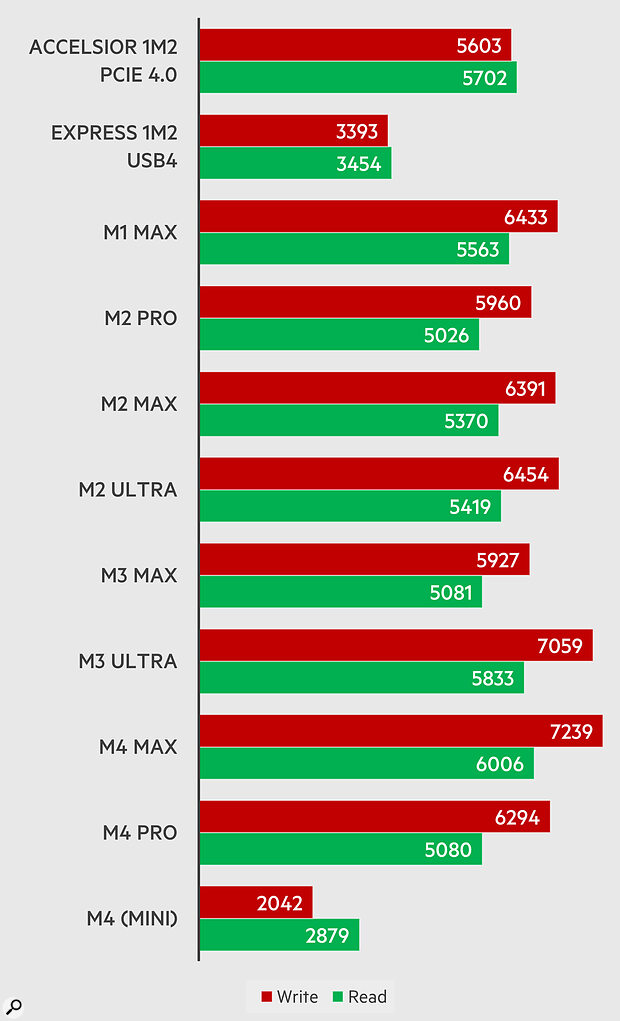 Figure 2: Blackmagic’s Disk Speed Test offers a glimpse at the read and write speeds of which the internal storage supplied with various Apple Silicon Macs are capable.
Figure 2: Blackmagic’s Disk Speed Test offers a glimpse at the read and write speeds of which the internal storage supplied with various Apple Silicon Macs are capable.
These speeds don’t make the machine unusable for recording and playing back audio tracks or running sample‑based instruments, but it’s something to bear in mind. The Mac mini with M4 is also available with 512GB storage — which is a more useful minimum — and you can configure a model with a 1TB or 2TB SSD if required. In terms of unified memory, the standard Mac mini starts with 16GB and can also be ordered with either 24 or 32 GB.
To Pro Or Not To Pro?
Like its M2‑based predecessor, the new Mac mini is again available in two models featuring either the M4 chip or the new M4 Pro variant. However, unlike its predecessors, these two models are externally indistinguishable from each other, since they both have the same number of connectors at the rear of the device. Aside from the figure‑8 power socket, there are three Thunderbolt (USB‑C) ports, HDMI and Gigabit Ethernet, which is configurable to 10Gb Ethernet.
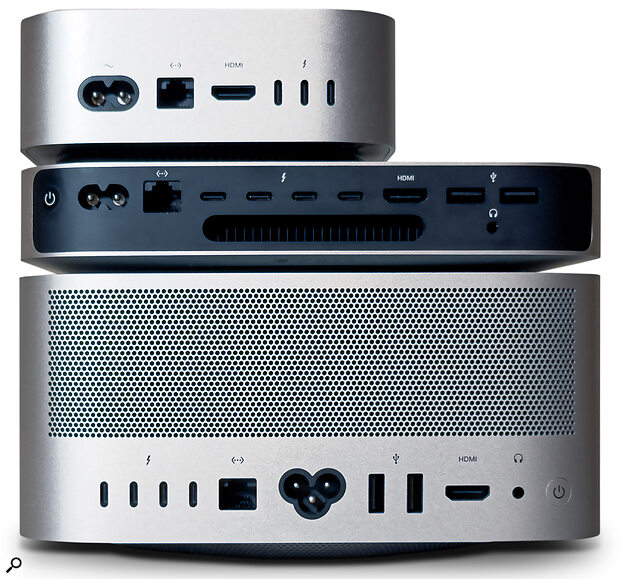 New (top) and old (centre) Mac minis atop a Mac Studio. The latest version really does justice to the ‘mini’ name!
New (top) and old (centre) Mac minis atop a Mac Studio. The latest version really does justice to the ‘mini’ name!
This means the entry‑level Mac mini now offers an additional Thunderbolt port compared with the previous M2‑equipped model, whereas the M4 Pro model has one fewer than its M2 Pro‑based predecessor. However, while the Mac mini with M4 supports Thunderbolt 4 and USB4 with a maximum speed of 40Gb/s, the M4 Pro model features a newer Thunderbolt 5 controller with USB4 v2.0 offering three times the maximum bandwidth at up to 120Gb/s for compatible devices (see box).
The Mac mini with M4 Pro includes 24GB unified memory as standard and is configurable with 48GB or even 64GB if needed — the previous model with M2 Pro could accommodate a maximum of 32GB. A 512GB SSD is also standard, with 1, 2, 4 and 8 TB options also available.
The Ultra Studio
The first thing you’ll notice about the new Mac Studio is, well, nothing, since it’s outwardly identical to the previous models. So, whilst it’s understandable that the new Mac mini features USB‑C connectors exclusively, I’m still delighted that the Mac Studio retains its pair of USB‑A ports at the rear, supporting USB 3.1 (up to 5Gb/s). In addition, both the M4 Max and M3 Ultra‑based Mac Studio models feature the same four USB‑C connectors at the back of the enclosure, supporting Thunderbolt and USB4. And, just like their predecessors, there’s an additional pair of USB‑C ports at the front offering USB 3.1 (up to 10Gb/s) or Thunderbolt on the models with M4 Max and M3 Ultra respectively.
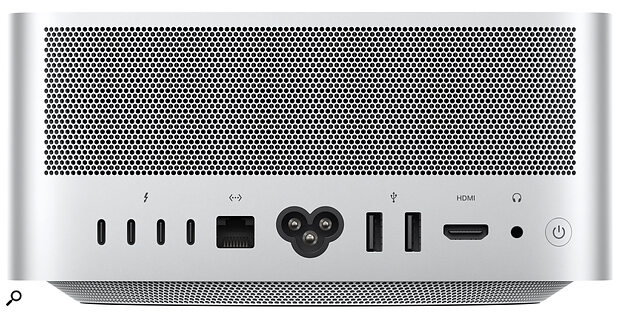 The M4 and M3 Ultra Mac Studios are outwardly identical to their predecessors.
The M4 and M3 Ultra Mac Studios are outwardly identical to their predecessors.
As with the M4 Pro‑based Mac mini, the new Max and Ultra Mac Studio models both support Thunderbolt 5 and USB4 2.0, which highlights an interesting point. When the M3 series was announced at the end of 2023, the M3 Max — upon which the M3 Ultra is based — implemented a Thunderbolt 4 controller and didn’t support version 5 (because it wasn’t yet released). In implementing the M3 Ultra, Apple’s engineers were able to retroactively add support for Thunderbolt 5, once again underscoring the advantage of controlling your own silicon destiny.
The base Mac Studio with M4 Max, which features a 14‑core CPU and 32‑core GPU, includes 36GB unified memory. The M4 Max‑based model, with a 16‑core CPU and 40‑core GPU, comes with 48GB as standard, but can also be ordered with 64 or 128 GB unified memory. For those who need more, both M3‑based Mac Studio models include 96GB unified memory as standard, with a 256GB option also available; and should this still not be enough, a 512GB configuration is also available if you’re purchasing the M3 Ultra featuring a 32‑core CPU and 80‑core GPU.
In terms of storage, the M4 Max and M3 Ultra‑based Mac Studio models include either a 512GB or 1TB SSD respectively, with 2, 4 or 8 TB options also available. Additionally, the Mac Studio with M3 Ultra can be ordered with a 16TB drive.
Black ’Books
As with the Mac Studio, there’s little to distinguish the external appearance of new M4‑series MacBook Pro models from the previous generation, except that Space Black has now vanquished Space Gray altogether, and every model of MacBook Pro is now available in either the foreboding Space Black or the traditional Silver finishes. Space Black employs a “breakthrough chemistry” intended to reduce the fingerprint marks that so often besmirch the appearance of such a dark finish and, in practice, works rather well.
 The new M4 MacBook Pro range features the options of a nano‑texture screen and Space Black finish.
The new M4 MacBook Pro range features the options of a nano‑texture screen and Space Black finish.
A particularly welcome addition to the latest MacBook Pro range is the option to add a nano‑texture coating to the display to minimise reflectivity. Unlike traditional matte finishes, which diffuse light through internal scattering, Apple’s nano‑textured glass diffuses light at the surface courtesy of an etching process that creates nanostructures directly on the glass. This reduces perceived glare whilst preserving image sharpness, colour vividness and contrast. Nano‑texture displays work surprisingly well in studio control rooms, which are often dimly lit and windowless, and sometimes have bright spotlights above the console.
Internally, the MacBook Pro models offer the same improvements as the new Mac mini and updated Mac Studio models, which is no surprise since the entire system is essentially contained within an M‑series package. The USB‑C ports on the MacBook Pros with either M4 Pro or M4 Max offer Thunderbolt 5 connectivity. As always, the only obvious improvement would be to incorporate an Ethernet port into the power supply, as Apple do with the iMac.
The MacBook Pro with M4 is available with either 16, 24 or 32 GB of unified memory. The M4 Pro‑based model can be ordered with 24 or 48 GB, but not the 64GB configuration that is available with the Mac mini. Like the base Mac Studio model, the MacBook Pro with M4 Max (featuring a 14‑core CPU and 32‑core GPU) includes 36GB unified memory, while the M4 Max model with a 16‑core CPU and 40‑core GPU comes with 48GB and can also be ordered with 64GB or 128GB.
Testing M1, 2, 3, 4
To benchmark the performance of Apple’s M4 family of custom silicon and the new M3 Ultra chip when running professional music and audio applications, I returned to the methodologies used when benchmarking the M2 and M2 Pro back in the July 2023 issue (www.soundonsound.com/reviews/apple-m2-macbook-pro-mac-mini-part-2). However, major new versions of both macOS and my test DAWs having appeared since those tests were performed, so I decided to upgrade and retest certain Macs from the earlier generations of Apple Silicon to put the latest chips in perspective. And it’s interesting to note how the older M1 Max and M2 Pro‑based systems actually perform better in almost every test with the latest macOS and application version than they did two years ago, which is definitely progress of a kind.
All applications were tested using default settings (unless specified otherwise) using the built‑in audio hardware with a buffer size of 128 samples at a 44.1kHz sample rate.
Logic Pro
Beginning with Apple’s own Logic Pro, real‑time performance was once again evaluated with a project consisting of stereo audio tracks, each with two instances of Amp Designer — employing, with the unerring instinct of an English musician, the Britannica Crunch preset — inserted on the corresponding channels. As I’ve noted before, this test is loosely based on information gleaned from Apple’s website some years ago when the company last detailed Logic Pro‑based comparisons on a Mac’s product page.
By default, the M4 and M4 Pro‑based Mac minis could play back 170 and 468 tracks respectively (and thus 340 and 968 Amp Designer instances) at the same time, while the MacBook Pro with M4 Max managed 572 tracks (using 1144 plug‑in instances) simultaneously. And although this is rather impressive, it gets better.
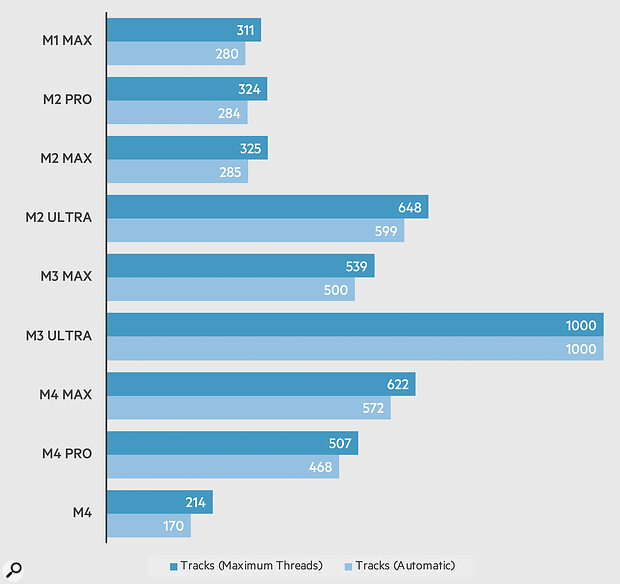 Figure 3: Maximum track counts achievable with Logic Pro. Note the outstanding performance of the M3 Ultra‑equipped Mac Studio.
Figure 3: Maximum track counts achievable with Logic Pro. Note the outstanding performance of the M3 Ultra‑equipped Mac Studio.
Logic Pro allows the number of active processing threads to be adjusted in the Audio page of the Settings window, making it possible to configure the number of cores used for audio processing. Apple recommend leaving the number of threads set to Automatic, which in most cases means only the P cores are deployed for audio processing, leaving the E cores free for handling other application and system tasks. (The track counts quoted reflect this Automatic setting.)
However, it’s possible to push your Mac even further by setting Processing Threads to the maximum number of CPU cores available. This means both the performance and efficiency clusters of cores will be used for audio processing, though it’s worth pointing out this option doesn’t always yield better performance in every situation. Because the E cores are, by definition, less performant than the P cores, it’s also possible to achieve less performance by employing them for audio processing, depending on the routing of a project. In this context, however, setting Processing Threads to the highest option with the test project described made it possible to play back 214, 507 and 622 tracks with M4, M4 Pro and M4 Max‑based Macs respectively, representing improvements of 26, 8 and 9 percent.
The reason for the large difference in the results between the M4 and M4 Pro (170 to 248, or 214 to 507) is due to the fact the M4 has four P cores where the M4 Pro on test has 10. This also explains why enabling the four E cores makes a bigger difference on the M4 than the Pro or Max variants, since switching from the Automatic setting to ‘8 Processing Threads’ represents a bigger increase in the number of cores available for audio processing.
Moving along to the Mac Studio with M3 Ultra, if you were expecting an improvement over the M4 Max to correspond the Geekbench multi‑core scores, you’re in for a shock, since this system effectively broke my test project. I hadn’t anticipated reaching the 1000‑audio‑track limit in Logic Pro, which happened with Processing Threads set to either Automatic or the maximum available. To compensate for this, I began adding extra pairs of Amp Designer instances to the tracks in order to synthesise a result that should have been available if more audio tracks were available. So, the results ended up being approximately 1013 and 1054 tracks with the Automatic and maximum settings, respectively.
To measure offline performance, I turned to the ‘Montero Spatial Audio’ demo project from Logic Pro 10.8, which I’d previously used when testing M2 performance. With Processing Threads set to Automatic, a surround bounce took 54, 24 and 20 seconds with M4, M4 Pro and M4 Max‑based systems respectively. The Mac Studio with M3 Ultra was slightly quicker, taking 18 seconds.
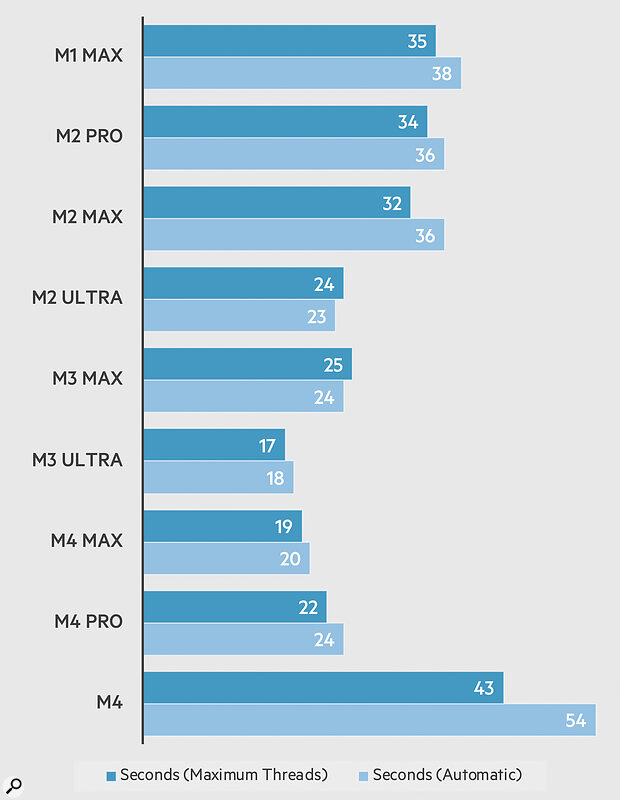 Figure 4: Offline bounce times in Logic Pro — shorter is better.
Figure 4: Offline bounce times in Logic Pro — shorter is better.
With Processing Threads set to the maximum, these rendering times for the M4, Pro and Max‑based systems were reduced to 43, 22 and 19 seconds respectively, while the M3 Ultra system shaves just a further second off the bounce time. Once again, the M4 receives the biggest bump, taking 20 percent less time to bounce when compared to using the Automatic setting.
Cubase
Steinberg’s Cubase Pro has one of the most interesting native audio engine implementations on Apple Silicon thanks to its ASIO Guard feature, which was discussed in detail in the second part of our extensive M2 review back in the July 2023 issue. And, with the release of version 14, Steinberg have added a new Dropouts section to Audio Performance Monitor that greatly assists in the benchmarking ritual. This section features a timeline to show Real‑Time and — if it’s enabled — ASIO Guard performance curves during playback, indicating any dropouts that occurred with a vertical red line at the appropriate timeline position.
In an ideal scenario, the Audio Performance Monitor would show no dropouts during playback. Therefore, in testing Cubase Pro, I set out to discover how far each system could be pushed before any dropouts were reported. However, since occasional dropouts can occur without being audible, or frequent enough to prevent you from working, I also decided to see how far playback could be pushed before it became impossible to continue. When ASIO Guard is enabled, this ‘peak’ is easy to find, since Cubase essentially acts out the DSP equivalent of throwing its hands up in exasperation.
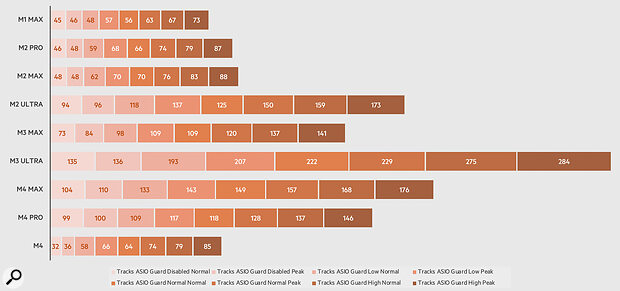 Figure 5: Real‑time track counts in Cubase, with the M3 Ultra once again showing its power.
Figure 5: Real‑time track counts in Cubase, with the M3 Ultra once again showing its power.
Using a project not dissimilar to the one created for Logic, I substituted the two instances of Amp Designer with instances of Steinberg’s bundled VST Amp Rack plug‑in, loaded with the Big Clean Reverb preset. With ASIO Guard disabled, the M4, M4 Pro, M4 Max and M3 Ultra‑based systems could comfortably play back 32, 99, 104 and 135 tracks simultaneously. Pushed into the red, the same machines reached track counts of 36, 100, 100 and 136 before the output became audibly unusable.
These small differences between the normal and peak track counts become more pronounced once ASIO Guard was enabled. With ASIO Guard set to Normal, the M4, Pro, Max and M3 Ultra‑based Macs played back 64, 118, 149 and 222 tracks without showing any dropouts, and 74, 128, 157 and 229 tracks until the systems waved the white flag. (Further increased track counts can be achieved by setting ASIO Guard to High, but the down side is that the latency of tracks being processed ahead of time using ASIO Guard can become annoyingly noticeable, especially when mixing.)
If these track counts don’t seem astonishingly high compared with Logic Pro, that is probably down to the relative demands of the respective plug‑ins. Ultimately, it’s the relative results between different Macs that demonstrate the real value of such tests.
For offline performance, I decided to export the project Steinberg supply to demonstrate the Iconica Sketch orchestral library, which employs 30 instances of Halion Sonic. Unlike Logic Pro, where the fastest system achieves the quickest result, the export times in Cubase don’t seem to follow a similar pattern.
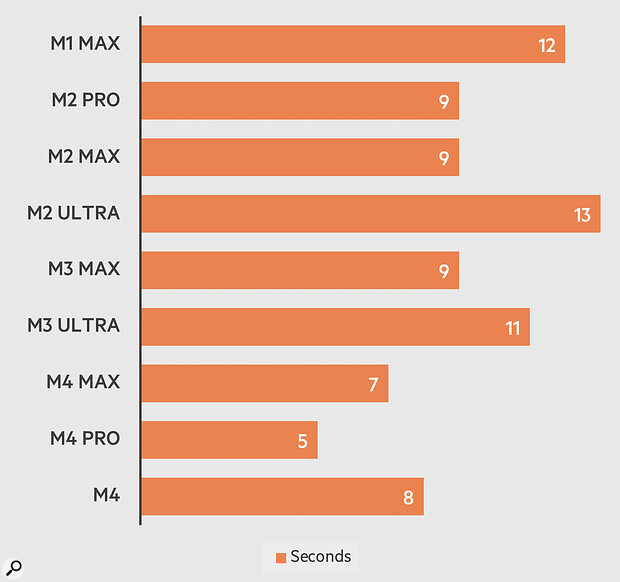 Figure 6: Offline bounce performance in Cubase doesn’t follow the pattern set in Logic.
Figure 6: Offline bounce performance in Cubase doesn’t follow the pattern set in Logic.
One explanation for this is that Logic’s bounce command is closely tied to the real‑time playback of a project, which is presumably why the settings of the audio engine affect the speed at which a project is bounced. This is obviously not the case in Cubase. When I performed the bounce on the Mac Studio M3 Ultra with Activity Monitor’s CPU History window open, it was clear that the system is being underutilised, with numerous cores barely showing up for work. More investigation is needed to fully understand what’s happening, although, to be fair, I’m quibbling about a few seconds here and there.
Pro Tools
Of the three applications tested, Pro Tools is by far the simplest to benchmark. There aren’t any settings to configure the native performance of the Avid Audio Engine for Apple Silicon, which is reassuringly straightforward. And you can observe from Pro Tools’ System Usage window that all 32 cores are available and being utilised, which can be confirmed by looking at Activity Monitor’s CPU Usage and History windows.
I should note that the latest version of Pro Tools (2024.10) is not officially supported on M4‑series Macs at the time of writing; full support is planned for the second quarter of 2025. The latest Mac Studio isn’t listed on Avid’s page detailing Supported Apple Computers, either, although one could presume that the M3 Ultra model should be fine.
To benchmark performance, I recreated a similar Session to those used for Logic Pro and Cubase, this time employing one instance of Eleven Mk II with the default preset on a stereo audio track. The M4, Pro and Max‑based systems could play back 69, 105 and 125 tracks respectively, once again showing performance relationships similar to those observed in the other applications. And, as anticipated, the M3 Ultra result also reveals a similar processing improvement of 74 percent over the M4 Max, with the ability to play back 218 tracks simultaneously — a 68 percent increase over the M2 Ultra.
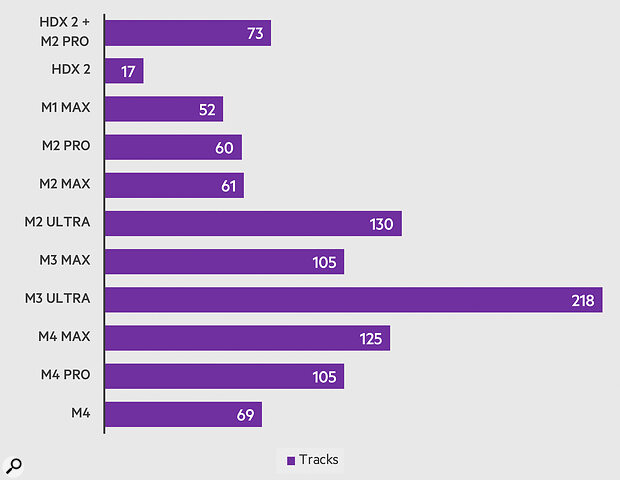 Figure 7: Real‑time track counts in Pro Tools.
Figure 7: Real‑time track counts in Pro Tools.
Given that Pro Tools can also employ dedicated DSP chips for running plug‑ins (or a combination of both DSP and native CPU resources in Hybrid mode), I also explored the performance of an equivalently configured session on a Mac mini with M2 Pro running a two‑card HDX system via an expansion chassis. Using only the DSP resources available (36 chips), it was possible to run just 17 tracks simultaneously. However, with Hybrid mode enabled, the track count increased to 73 — 13 more tracks than running natively on the M2 Pro system without HDX hardware.
Eleven Mk II requires two DSP chips (each consuming 96 percent) to run two mono instances when used as a multi‑mono instance on a stereo track, with two DSP chips required for Mixer instances (or just one instance in Hybrid mode). Since Pro Tools HDX is now over 13 years old, though, it’s not all that surprising the raw DSP resources of HDX can be outdone by modern Apple Silicon chips. After all, there are still situations where HDX systems are useful in terms of providing a large number of audio inputs and outputs at low latency, especially when tracking.
To evaluate offline performance, I bounced the ‘Final Mix’ session for Sol Levante, which is made available under Netflix’s Open Content program (https://opencontent.netflix.com), using Pro Tools’ internal Dolby Atmos renderer. Given that offline bouncing in Pro Tools is always processed natively, there was no need to include HDX systems for these tests.
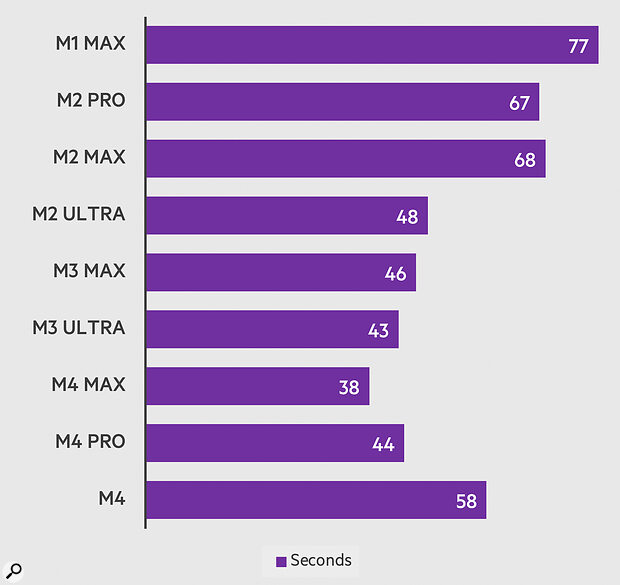 Figure 8: As in Cubase, offline bounce times in Pro Tools don’t straightforwardly mirror the raw processing power of the system.
Figure 8: As in Cubase, offline bounce times in Pro Tools don’t straightforwardly mirror the raw processing power of the system.
As you see from the chart, the M4 Max is again quicker (by six seconds) than the M3 Ultra, offering about the same performance as the M4 Pro. Again, as with Cubase Pro, this is presumably because bouncing in Pro Tools doesn’t efficiently scale to use as many CPU cores as are available. It could equally be that this particular session can’t be bounced any quicker than with the 16 cores provided by the M4 Max, and that trying to deploy additional cores simply adds scheduling overhead.
The Mac mini is the best it’s ever been, and the company’s engineers have redefined what ‘mini’ means.
Conclusion
Apple’s engineers have really outdone themselves with the company’s latest Macs and M‑series silicon. The Mac mini is the best it’s ever been, and the company’s engineers have redefined what ‘mini’ means. It’s also something of a bargain; when the M1 model with 8GB memory launched in November 2020, it cost $699 (around $860 adjusted for inflation). Now, released just four years later, you can buy a Mac mini with M4 and 16GB memory for $599.
But it’s not just at the low end Apple have been busy. While the Mac Studio might not be powered by the M4 Ultra you were looking for, the M3 Ultra delivers the performance even an insomniac has always dreamt about. However, as desirable as the Mac Studio with M3 Ultra undoubtedly is, it’s also likely to offer more performance than many of us actually need — unless, of course, you’re a composer working with big arrangements, even bigger track counts and sample‑based instruments so dense they could turn any SSD into a black hole.
The M4 Pro and M4 Max‑based Macs, whether mini, Book or Studio, represent an extraordinarily capable middle ground, especially since the M4 Max offers comparable performance to Apple’s previous high‑end chip, the M2 Ultra — which still powers the current Mac Pro. And the 14‑ or 16‑inch MacBook Pros, powered by either the M4 Pro or M4 Max chips, remain simply the best notebook computers for musicians and audio engineers. When you consider the performance of the M4 chips, particularly the M4 Max, the near‑silent operation and long battery life, the speed of the internal storage, the inclusion of Thunderbolt 5 and pretty much everything else, it’s hard to reach any other conclusion.
Thunderbolt 5
The adoption of Thunderbolt 5 for Macs powered by either the M4 Pro, M4 Max or M3 Ultra chips is going to be a big deal for musicians, particularly those who work with large sample‑based instruments. The internal storage on all but the most basic Apple Silicon Macs has always been capable of fast read and write speeds, but until now, only the Mac Pro has afforded the option to add extra storage capable of similar performance.
For example, using a 1TB WD Black SN850X M.2 SSD attached to a Mac Pro via OWC’s ‘Accelsior 1M2 M.2 SSD to PCIe 4.0’ card, Blackmagic’s Disk Speed Test reported read and write speeds of 5702 and 5603 MB/s respectively. Which isn’t too shabby for an SSD that’s quoted as having sequential read and write rates of 7300 and 6300 MB/s. However, when connecting this same SSD externally via Thunderbolt 4 with the fastest enclosure I could find that supports 40Gb/s — OWC’s Express 1M2, which connects using USB4 — I achieved read and write speeds of 3454 and 3393 MB/s.
Although respectable, and more than fast enough if you’re primarily working with audio tracks, this speed is still about 40 percent less than the performance offered by connecting the same SSD to an internal PCIe 4.0 slot. And this translates into noticeably longer load times when working with large sample‑based instruments located on external storage. Changing patches is less snappy, and opening a project from scratch can become the moment you decide it’s time to put the kettle on.
Thunderbolt 5 will change the game for those wishing to attach fast external storage. Unlike Thunderbolt 4, which implemented PCIe 3.0, required full compatibility with USB4, and offered transfer speeds of 40Gb/s, Thunderbolt 5 supports both PCIe 4.0 and 5.0, including USB4 2.0, and achieves transfer speeds up to 120Gb/s — with one slight caveat. This maximum speed can only be achieved unidirectionally with what’s referred to as ‘Bandwidth Booth’ mode, meaning that either reading or writing data is prioritised, reducing the amount of bandwidth available in the other direction to less than 40Gb/s.
This is great if you’re working with large sample libraries, since you’d want to prioritise reading when working with an instrument and then writing only when downloading or copying sample data to that drive. In normal usage, though, where read and write bandwidth is more or less equal, such as when recording and playing back audio tracks simultaneously, Thunderbolt 5’s default mode enables bidirectional transfers of 80Gb/s in each direction. Therefore, when used with a suitable M.2 NVMe SSD with support for PCIe 4.0 or 5.0, real‑world bandwidth could be in the range of 8000 to 15,000 MB/s, depending on the mode being used. Unfortunately, though, although many Thunderbolt 5‑capable docks and storage peripherals have been announced, none seem to be available to buy at the time of writing.
Accelerated Learning
Given that Apple’s M‑series silicon has always incorporated a Neural Engine for accelerating neural‑network‑based computation, you might be wondering why the CPU cores would also need to provide accelerators for machine learning. The simple reason is that while the Neural Engine excels at duties such as object detection, voice recognition, classification and image processing, it’s not equally suited to every ML task. This is because the Neural Engine is designed for efficient inference, which is to say running pre‑trained models rather than training new ones from scratch. It works best with structured data and models that can leverage lower numerical precision. In fact, given these prerequisites, the Neural Engine can handle an insanely high throughput, measured in trillions of operations per second (TOPS), using far less energy than a CPU or GPU.
When it comes to audio processing, the Neural Engine can be useful for some tasks, such as noise reduction, classification, voice isolation, or detecting so‑called wake words — such as “Siri” — but it’s less useful for reverbs, delays and complex filter structures, oscillator‑based synthesis, or higher‑precision 32‑ or 64‑bit floating‑point arithmetic. So, audio software might use the Neural Engine to recognise what type of drum sound a sample contains (such as kick, snare, hi‑hat, and so on), but rely on the CPU’s ML accelerators or the GPU for separating the drum sounds from a mixed audio track.
The Windows Comparison
Many people will want to know how the M4‑series Macs and the M3 Ultra‑based Mac Studio discussed in this article fare against alternative systems from Windows‑based competitors. However, this is an extremely difficult comparison to make. For one thing, Apple have set the bar so high in terms of the amount of energy required to achieve a given performance level, it’s hard for other manufacturers to come close. And this is in no small part due to Apple’s vertical integration, meaning the company’s engineers control every aspect of the system: from the power supply and silicon to the enclosure and the operating system.
One direct consequence of this is fan noise — or the lack thereof. A quiet system might be a luxury to some users, but can be very important to musicians and audio engineers who don’t necessarily have access to a machine room.
However, if one were to make comparisons, let’s first consider the Mac Studio. If imitation is indeed the sincerest form of flattery, then you don’t need to look much further than Lenovo’s ThinkCentre Neo Ultra. A system with the fastest processor option (a 14th‑generation Intel Core i9‑14900 processor), 32GB memory and 512GB storage comes to £2031.49$2149.68, which is as close to the Mac Studio base model with M4 Max I could find. In this case, you’re getting 4GB less memory, but with six USB‑A ports, no Thunderbolt 5, and one USB‑C connector offering USB up to 20Gb/s.
Although Geekbench’s results aren’t always an accurate indicator of real‑world performance, with single‑core and multi‑core scores of 2889 and 17479 respectively, this system is not only outperformed by the M4 Max, but by the Mac mini with M4 Pro as well. And for not much more, you can get such a system with an M4 Pro featuring a 14‑core CPU, a 20‑core GPU, faster connectivity options, 48GB memory, and 1TB storage.
HP’s Z‑range of workstations are a solid choice when it comes to pre‑built Windows systems ideal for music and audio, especially since Avid officially support Pro Tools on most models and Steinberg have recommended them in the past. The cost of a midrange Z2 G9 Tower Workstation with an Intel Core i9‑14900K processor, 64GB memory and a 512GB SSD is $2525.82, at the time of writing. (HP don’t offer the same configurations in the UK.) According to the Geekbench Browser, the 14900K scores 3193 and 21540 in the single‑ and multi‑core tests, thanks to being capable of a higher clock speed than the standard 14900, which is a level of performance to the M4 Pro. A Mac mini with M4 Pro and the same 64GB memory and 512GB SSD comes out at $2199. The HP Z2 G9 offers internal PCIe slots, but doesn’t feature Thunderbolt connectivity.
While the MacBook Pro undoubtedly carries a high‑end price tag, it’s not unreasonably expensive when you consider the performance. For example, a 16‑inch MacBook Pro with M4 Max fully loaded with 128GB memory and 8TB storage will set you back £7349$7349. However, a similarly specified Mac Studio with an M3 Ultra (with 128GB and without the higher number of GPU cores) with roughly the same CPU performance is priced at £7999$6999. When you consider the MacBook Pro is portable and includes a 3456 x 2234, nano‑textured display, it doesn’t seem like such a bad deal.
If we turn our attention to a comparable Windows laptop, let’s consider the venerable Lenovo ThinkPad P1 Gen 7 mobile workstation. Featuring an Intel Core Ultra 9 185H processor with 64GB memory (since no 128GB option is available), two 4TB M.2 2280 drives (since there’s no single 8TB) option, and a 16‑inch, 3840 x 2400, anti‑reflective OLED display with touch, this model is available for £4475.99$4174.46 (the online Lenovo‑discounted price at the time of writing). A saving of £2873$3264.54 over the MacBook!
However, the Core Ultra 9 185H processor scores 2250 and 12033 in Geekbench’s single and multi‑core tests — 44 and 54 percent lower than the MacBook Pro with M4 Max. And if we reconfigure the MacBook Pro with 64GB memory and 4TB of storage, the price drops dramatically to £5349$5199, making it merely £1409$1433.12 more expensive than the ThinkPad P1 with a single 4TB drive (£3940$3765.88). But, given that the Core Ultra 9 chip scores lower than the M4 in terms in Geekbench’s CPU tests, that price differential represents more than twice the performance.
Pros
- The new Mac minis are much smaller and lighter than their predecessors, offer better performance, and are more affordable.
- Thunderbolt 5 on many models for lightning‑fast external storage.
- The MacBook Pro offers a potent combination of power and efficiency plus the excellent nano‑texture screen.
- New Mac Studio models offer huge performance gains, especially with the new M3 Ultra chip.
Cons
- As usual, the cost rises quickly with specification level.
- The base 256GB M4 Mac mini has slower storage than the other models.
Summary
The base M4 Mac mini models are capable computers representing great value, while the M4 Pro models offer plenty of power for music and audio. The new Mac Studio and MacBook Pro can be costly, but the former is the most powerful Mac ever, and by a large margin — and the latter is unquestionably the best laptop available for musicians and producers.
Information
Mac mini from £599; MacBook Pro from £1599; Mac Studio from £2099. Prices include VAT.
Mac mini from $599; MacBook Pro from $1599; Mac Studio from $1999.
Test Spec
- Apple Mac mini with M4 (four Performance cores and six Efficiency cores), 16GB memory and 512GB storage.
- Apple Mac mini with M4 Pro (10 P cores, four E cores), 48GB memory and 1TB storage.
- Apple MacBook Pro with M4 Max (12 P cores, four E cores), 40‑core GPU, 128GB memory and 4TB storage.
- Apple Mac Studio with M3 Ultra (24 P cores, eight E cores), 256GB memory and 4TB storage.
- All systems running macOS 15.3.1 (Sequoia).
When you purchase via links on our site, SOS may earn an affiliate commission. More info...
